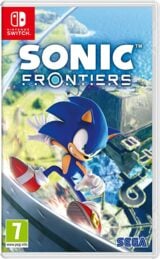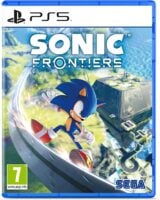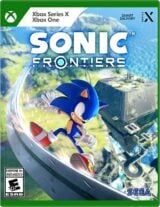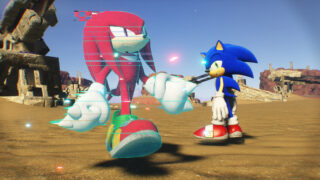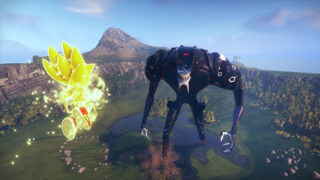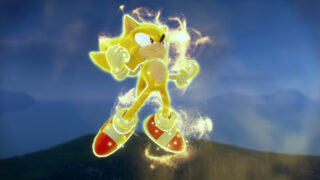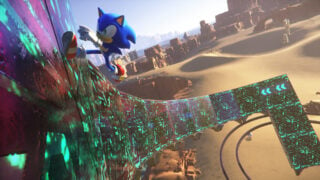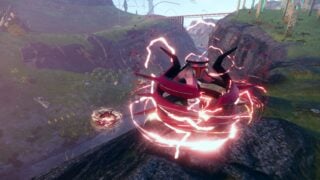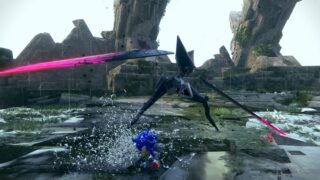And for those curious about how tight the controls are this time, here's an S-Rank run I recorded from one of the early linear stages. pic.twitter.com/HjOv3L9joA
— Chris Scullion (@scully1888) November 7, 2022
Review: Sonic Frontiers is a fine return to form for the series
Sega’s open-world adventure is the kick up the backside 3D Sonic has been crying out for
- Director
- Morio Kishimoto
- Key Credits
- Sachiko Kawamura (Producer), Ian Flynn (Writer)
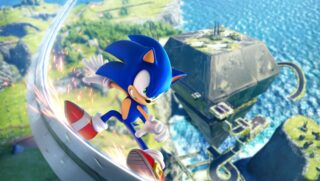
It may be tempting to compare Sonic Frontiers to Legend of Zelda: Breath of the Wild, but the latest Sega platformer actually has more in common with a different Nintendo exclusive.
As a neat bookend to 2022, Frontiers reminds us a lot more of Pokémon Legends: Arceus, which was released back in January. That ended up being the first big pleasant surprise of this year, and Frontiers is one of the last.
Much like Pokémon, parts of the Sonic fanbase have been crying out for fundamental changes to the series for some time now. Both series had nestled a little too comfortably into a predictable formula, and despite new gimmicks and generational upgrades it had been too long since either had enjoyed any truly revolutionary gameplay revamps.
Pokémon’s solution was to go properly open-world, giving the player true freedom to explore its environments, with quality of life improvements made to ensure everything ticked along at a nifty pace. With Sonic Frontiers, Sega has come to almost exactly the same solution, and the results are just as satisfyingly refreshing.

The story in Frontiers starts deliberately vague, and in respect of that, we’ll opt not to shed further light on it, other than to say it involves a strange ‘cyber world’ which ultimately gives fans of the series some backstory on what happened in Sonic’s world a long time ago. It’s a narrative that starts off quite slowly at first but eventually becomes one of the most engaging in the series, but more on that later.
The game’s main meat is its five open-world islands, four of which are large expanses filled with things to do. Each island starts with a completely hidden map, and as you explore you’ll find loads of small ‘missions’ represented by question mark icons floating in the world itself. Near each of these question marks is some sort of small task, of which there are a wide variety.
This could be something tiny – like parrying some missiles or playing jump rope with a laser beam – or something more involved, such as hitting a distant switch before a timer runs out, or solving puzzles with floor tiles, Tetris blocks or the like. The sheer number of these missions means there’s some repetition over the course of the game, but most are over so quickly that it’s nice to just breeze around the world ticking them off.
As you complete each mission, it’ll reveal a small part of the map, and create part of a rail network (as in grinding rails, not the London Underground or anything). Part of the open-world routine, then, involves running around and taking on these missions to build the map and reveal the other features to be found.
Eventually, players end up with a huge world map filled with icons – the best way to describe it is to imagine a typical Ubisoft open-world game, but played on fast-forward and therefore less tedious. The idea of a world that progressively fills with more rails, springs and speed boosts as you play through it may start to cause Sonic fans to break out in a cold sweat.
The series hasn’t exactly been renowned for its stability and the more chances there are for something to glitch, the more potential there is for frustration. Thankfully, this is about as stable as 3D Sonic has been.
There are some sections, especially when climbing the occasional large tower (the Ubisoft / Breath of the Wild effect again) where a series of pinpoint jumps and homing attacks are needed to ascend. In past days these would likely have had players turning the air bluer than Sonic’s bristles due to countless stumbles that weren’t their fault, so the notion of a game filled with such traversal will understandably be a concern.
“The idea of a world that progressively fills with more rails, springs and speed boosts as you play through it may start to cause Sonic fans to break out in a cold sweat.”
It needn’t be – this time, the controls are tight enough that such moments are rare, and on the odd occasion when a player does slip up the game has measures in place – be that infinite lives, or large zip lines which carry them back up to the top if they fall from a large height – to minimise the number of swear words uttered.
Those hoping for more traditional 3D Sonic stages can rest easy, because there’s still plenty of that to be found too. Each world has a series of temple-like buildings which act like the shrines in Breath of the Wild, but rather than Zelda’s underground tombs each instead leads the player to a cyber-world recreation of a classic Sonic zone, be that Green Hill or Chemical Plant.
There are 30 of these stages in total, and while they’re generally shorter than in previous Sonic games, it’ll still take a while to tick off the missions in each (clearing the stage, beating a set time, collecting a set number of rings and collecting all red rings).
Because the temples are dotted around the map and don’t all have to be cleared to progress, it’s possible to beat the game while only playing around half of these stages, but without going into too much detail, there’s an opportunity to play the rest after the credits roll.
However, this is not a Sonic Adventure situation, where the linear levels are the main event, and the open world is little more than an elaborate hub to join them together. In Frontiers the open world is very much the star of the show: the stages, while welcome, aren’t necessarily needed and almost feel as if they’ve been put in there to keep the hardcore fans happy (though are they ever?).
The other major gameplay element this time is combat. As in (you guessed it) Breath of the Wild, the world is inhabited by numerous enemy types and some drop vital collectibles when defeated, so players will have to be prepared for more engaging combat than the typical homing jump attack seen in most other Sonic games.
“In Frontiers the open world is very much the star of the show: the stages, while welcome, aren’t necessarily needed and almost feel as if they’ve been put in there to keep the hardcore fans happy”
For the most part, this works well enough, with most enemies acting almost like mini boss fights and requiring different strategies to take down. Once they’re locked on and Sonic is dishing out a beatdown there are a variety of special techniques which can be unlocked through a skill tree. If these prove a little tricky to pull off the skill tree also includes an ‘Auto Combo’ skill which, once unlocked, gives you a toggle that performs special moves automatically.
When it all comes together, then, everything works rather well, and it doesn’t hurt that the game looks and sounds great too. The PS5 version contains a 4K mode and a 60fps mode – the latter is far and away the one to go for because although the resolution drops the loss of detail is barely noticeable and a game this fast really benefits from that smoother frame rate.
Combine its lush landscapes with a superb soundtrack – complete with wonderfully catchy cheesy rock during the more epic boss fights – and this is easily the most visually and aurally impressive Sonic game to date. And it may well be the one with the best plot, too.

Sonic games are usually infamous for having storylines that range from awful to forgettable, but Frontiers tells a compelling story with a new main character, Sage (who seemingly goes to the same hairdresser as Rosalina from the Mario games), who will constantly keep players intrigued until the final surprising reveal.
Without getting into any other details, while this may not be Sonic Adventure 3, fans of the Dreamcast titles will be happy to see some acknowledgement here. Even Eggman voice actor Mike Pollock gets to cover all the emotions this time, with some surprisingly poignant moments. The only slight distraction is Roger Craig Smith, who’s opted to give Sonic a deeper voice this time for some reason.
Of course, it is still a Sonic game when all is said and done, and as such, it isn’t completely without its issues. The camera can prove a little annoying at times, and one or two controls can be a tad unpredictable.
“Sonic games are usually infamous for having storylines that range from awful to forgettable, but Frontiers tells a compelling story with a new main character, Ares, who will constantly keep players intrigued until the final surprising reveal.”
Wall running, in particular, can be hit or miss at moments (though as previously said at least the game has measures in place to mitigate this), and sometimes pulling off specific combo moves in the heat of battle can be a pain, especially later in the game when even some of the standard enemy fights in the open world can get quite elaborate.
Compared to past Sonic games, though, any quibbles that pop up are far less intrusive and appear nowhere near as frequently as they did in the past. The net result here is an extremely positive one, even if it borrows more ideas than a late-night chat show host.
Yes, the general world design has clearly been ‘inspired’ by Breath of the Wild (and don’t get us started on the Kocos, collectible creatures which are blatantly supposed to be Koroks). And yes, throughout the game’s 20+ hour duration there will be plenty of other sections that feel familiar – a bit of Shadow of the Colossus here, a touch of Ikaruga there – but at least the giants of whose shoulders it’s chosen to stand are legitimate titans.

This brings us back to Pokémon Legends: Arceus. Hindsight is a wonderful thing, but anyone familiar with that game’s build-up will remember a lot of negativity before its release, which quickly dissipated when people discovered it was actually the kick up the backside the franchise needed.
Unless you haven’t been paying attention, you’ll have seen that Sonic Frontier has had a similarly rocky road to release. Early reception was mixed, and Sonic Team studio head Takashi Iizuka was found in interviews (including one with VGC) reassuring players that the backlash wasn’t going to result in the game being delayed until 2023, because they were perfectly happy with it, thanks very much.
Well, credit where credit’s due – he was right. Sonic Frontiers is easily one of the finest 3D Sonic games ever made, right up there with Sonic Generations and Sonic Adventure 2 as a truly accomplished effort that hits a lot more than it misses.
It may have had a mixed reception earlier this year, but Sonic Frontiers' final form is a brilliantly refreshing adventure that gives the series a much-needed shake-up. The occasional control and camera 'quirks' still pop their head up, but they appear far less frequently than Sonic fans will be used to, making for a much less frustrating experience overall. We would absolutely welcome more of this.
- Exploring its open worlds is a treat
- A healthy selection of linear stages to play through too
- A solid 20-hour adventure with a surprisingly engaging plot
- Visually gorgeous at times on current-gen, and the soundtrack is superb
- Camera and controls still occasionally play up, though they've been tightened up a lot
